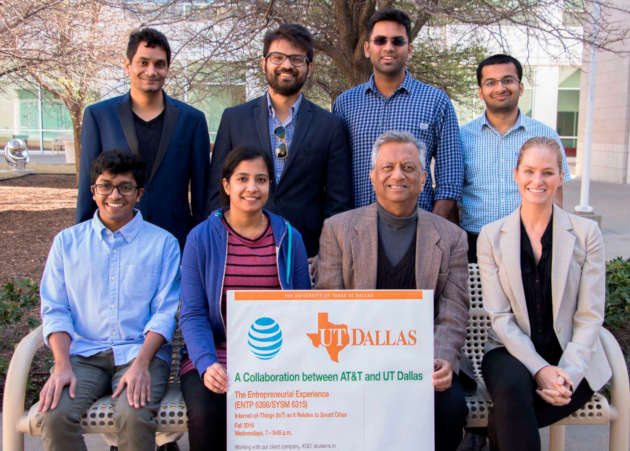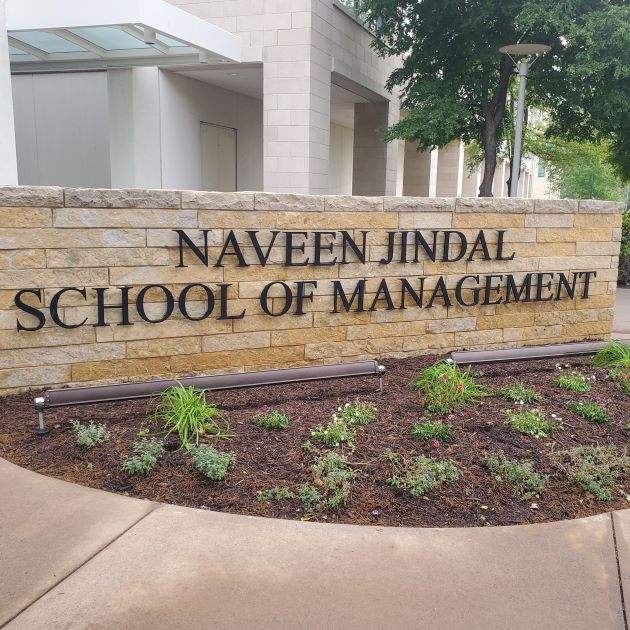
Graduate students who recently took an entrepreneurship course at the Naveen Jindal School of Management walked away from the experience knowing that they had made a significant real-world contribution.
The class, The Entrepreneurial Experience (ENTP 6398), gave students an opportunity to engage with AT&T Smart Cities. Taught by Dr. Rajiv Shah, an innovation and entrepreneurship professor and director of the MS in Systems Engineering and Management program, the students shared their ideas on how AT&T, using its Smart Cities framework and internet of things innovation, should expand its products and solutions into new cities.

Smart Cities is a framework of interconnected technologies that use wireless networks, and telecommunications networks in general, to help connect communities with city infrastructures. Smart Cities’ solutions target problems associated with dense urban and suburban areas —congestion, limited parking, energy-intensive streetlights — as well as safety and security issues and larger infrastructure issues such as power outages, wear and tear of bridges and roads and water leaks. A Smart Cities app, for instance, might automate notification of the need for garbage collection or that a streetlight has stopped functioning properly. Or it could tell a driver that a parking spot has become available or that a streetlight has stopped functioning properly. Cities can detect and monitor outages and notify citizens in near-real time.
As part of the course, the students focused on helping AT&T Smart Cities identify and develop potential business opportunities and document data within five key vertical markets: energy and utilities, transportation, citizen engagement, public safety and infrastructure.
“Smart Cities is about connectivity and collaboration,” said Mike Zeto, general manager and executive director, AT&T Smart Cities. “The Jindal School is known for fostering innovation, so it only made sense to collaborate with the school to identify solutions that would help us address challenges in these key verticals.”
Students in the class split into five groups, each in charge of a region within the U.S.: Northeast, South Atlantic, North Central, South Central and West. The students were tasked first with identifying companies that provide connected solutions to cities from their assigned regions, as well as the value chains and value propositions those companies could offer.
Next, each team researched and identified target cities for its respective region. Students researched global cities that already have employed smart-city solutions from the five targeted verticals so that they could determine what city within their region would most benefit from similar smart-city solutions from AT&T.

From there, each team formulated a go-to-market strategy for its target city. All teams proposed partner companies that could implement the solutions for AT&T, what solutions those companies could offer, potential business models, revenue opportunities, cost savings, environmental sustainability impact available from implementing those solutions, market size, potential level of interest, pricing, promotion and rollout plans, capital and investment required — basically all the elements of a corporate internal startup launch.
Employees from AT&T Smart Cities and Internet of Things business units were available to the student teams as domain experts and consultants. Students benefited from being in close proximity to the City of Dallas, which is rolling out its own Smart Cities effort in collaboration with AT&T — one being spearheaded by Jennifer Sanders, executive director of the Dallas Innovation Alliance. Not only were the students able to witness a real-life Smart City while working on the project, but the school’s relationship with the group offers an opportunity for further engagement between UT Dallas and City of Dallas efforts in Smart Cities.
“The methodology is there,” Shah said. “There’s a lot of research and analysis that’s gone into this project. Mike Zeto and the other AT&T Smart Cities project members we worked with will already have a solid case to take to their managers to explain why they should roll it out in each one of those cities.”
The cities selected by the five teams were Providence, R.I.; Columbus, Ohio; San Jose, Calif.; Austin, Texas; and Orlando, Fla. Although there was no guarantee that AT&T would immediately pursue those cities, the company nonetheless benefited from the students’ findings.
“The solutions proposed by the students in Rajiv’s class reveal high levels of creativity, intelligence and academic rigor,” Zeto said. “Those traits are all needed to help us drive value to our customers as we continue to provide world-class solutions for cities.”





